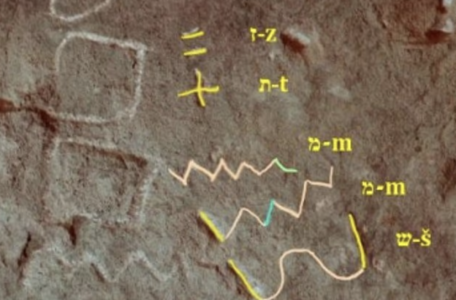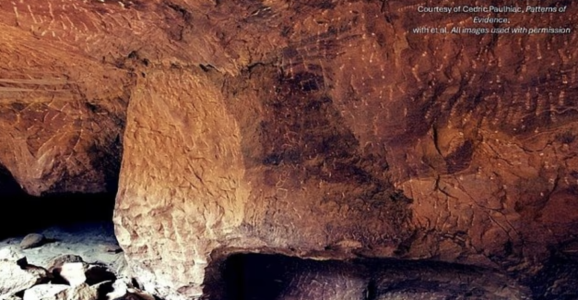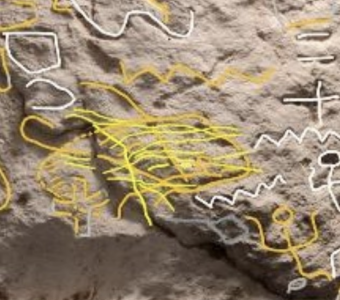Could this ancient inscription reveal the truth about Moses?
By
Veronica E.
- Replies 0
For generations, the story of Moses leading the Israelites out of Egypt has been passed down through scripture, tradition, and faith.
But now, a discovery in an ancient Egyptian mine is raising fresh questions—and eyebrows—among historians and believers alike.
At the heart of the find is a 3,800-year-old inscription that some researchers believe may contain the earliest known mention of Moses.
If true, it could be one of the most significant archaeological links to the Bible’s Exodus narrative ever uncovered.
But not everyone agrees on what the ancient text really says—or what it means.

Unearthed in Sinai: A message through time
Deep within the turquoise mines of Serabit el-Khadim on Egypt’s Sinai Peninsula, archaeologist Michael Bar-Ron claims to have identified an inscription in a rare early alphabetic script called Proto-Sinaitic.
The phrase, allegedly reading “This is from Moses” in Hebrew—“zot m’Moshe”—may be the oldest known mention of the biblical figure.
If accurate, the inscription dates back to around 1800 BC and could lend historical weight to the Exodus story.
The possibility that Semitic-speaking laborers—perhaps early Israelites—left behind a message referencing Moses has sparked both excitement and caution in the academic world.
An ancient script, a modern controversy
Proto-Sinaitic script is notoriously difficult to translate, with incomplete characters and symbols often open to interpretation.
Egyptologist Dr. Thomas Schneider cautions against reading too much into these marks, warning that claims like Bar-Ron’s can lead to misleading or overly speculative conclusions.
Still, Bar-Ron isn’t alone.
His advisor, Dr. Pieter van der Veen, stands by the reading, and the team used 3D scanning to enhance clarity.
But as of now, their research has not been peer-reviewed—leaving the scholarly community divided.
Also read: Lost civilization discovered beneath the world's largest desert
Traces of conflict: religion, resistance, and rebellion
The inscription isn’t the only point of intrigue in the mine.
Other markings reference gods like Baʿalat and El—the latter being the early Hebrew name for God.
Some inscriptions appear to have been deliberately altered or defaced, suggesting a time of religious turmoil or transition.

Nearby ruins of a destroyed temple and inscriptions referring to “the accursed one”—believed to be Pharaoh—add to the theory that a rebellion or uprising may have occurred here.
The miners, once enslaved or heavily supervised, may have rejected Egyptian authority and left behind cryptic signs of their resistance—echoing themes from the Book of Exodus.
Artifacts such as seals belonging to Semitic officials and the Stele of Reniseneb further suggest the presence of a Semitic elite in Egypt, possibly linking this site to the era of Joseph, another biblical figure.

Also read: New search effort aims to solve mystery of Amelia Earhart’s disappearance
Faith and fact: can both be true?
While some may see this as a possible confirmation of biblical events, others remain cautious.
Translating ancient scripts is as much art as science, and scholars remind us that assumptions can easily shape what we think we see.
Even Bar-Ron admits to approaching the inscription critically, entertaining other interpretations before settling on “Moses.”
Regardless of the final verdict, the discovery has opened a rare window into a moment of ancient history—one marked by shifting beliefs, social upheaval, and the resilience of those who lived through it.

Also read: Archaeologists stunned: Could this newly discovered carving in the US rewrite what we know about Jesus’ crucifixion?
A story that still resonates today
For many, the idea that Moses’ name may be etched into stone brings history vividly to life.
It reminds us that stories passed down through generations might still have echoes in the archaeological record.
Whether you’re a believer, a skeptic, or simply fascinated by the ancient world, these discoveries invite deeper questions and reflection.
Even after thousands of years, new findings in forgotten corners of the world continue to challenge and inspire us.
Whether this inscription is proof of Moses or just another ancient puzzle, it shows how much we still have to uncover—and how the past still speaks, if we’re willing to listen.
Read next: What if everything you know about sleep is wrong? How a scientist finally cured his insomnia

Do you believe this inscription could truly reference Moses? Have you ever visited a historic site that made the past feel real? Or do you think the meaning of faith goes beyond anything carved in stone? Share your thoughts and favorite historical mysteries—we’d love to hear your perspective.
But now, a discovery in an ancient Egyptian mine is raising fresh questions—and eyebrows—among historians and believers alike.
At the heart of the find is a 3,800-year-old inscription that some researchers believe may contain the earliest known mention of Moses.
If true, it could be one of the most significant archaeological links to the Bible’s Exodus narrative ever uncovered.
But not everyone agrees on what the ancient text really says—or what it means.

A centuries-old Egyptian site at the center of renewed interest in the story of Moses. Image Source: YouTube / Netflix.
Unearthed in Sinai: A message through time
Deep within the turquoise mines of Serabit el-Khadim on Egypt’s Sinai Peninsula, archaeologist Michael Bar-Ron claims to have identified an inscription in a rare early alphabetic script called Proto-Sinaitic.
The phrase, allegedly reading “This is from Moses” in Hebrew—“zot m’Moshe”—may be the oldest known mention of the biblical figure.
If accurate, the inscription dates back to around 1800 BC and could lend historical weight to the Exodus story.
The possibility that Semitic-speaking laborers—perhaps early Israelites—left behind a message referencing Moses has sparked both excitement and caution in the academic world.
An ancient script, a modern controversy
Proto-Sinaitic script is notoriously difficult to translate, with incomplete characters and symbols often open to interpretation.
Egyptologist Dr. Thomas Schneider cautions against reading too much into these marks, warning that claims like Bar-Ron’s can lead to misleading or overly speculative conclusions.
Still, Bar-Ron isn’t alone.
His advisor, Dr. Pieter van der Veen, stands by the reading, and the team used 3D scanning to enhance clarity.
But as of now, their research has not been peer-reviewed—leaving the scholarly community divided.
Also read: Lost civilization discovered beneath the world's largest desert
Traces of conflict: religion, resistance, and rebellion
The inscription isn’t the only point of intrigue in the mine.
Other markings reference gods like Baʿalat and El—the latter being the early Hebrew name for God.
Some inscriptions appear to have been deliberately altered or defaced, suggesting a time of religious turmoil or transition.

An independent researcher has reanalyzed ancient inscriptions in Egypt and believes they may contain the earliest written reference to Moses—possibly reading, “This is from Moses.” Image Source: Johannes Gutenberg-University of Mainz / The Daily Mail.
Nearby ruins of a destroyed temple and inscriptions referring to “the accursed one”—believed to be Pharaoh—add to the theory that a rebellion or uprising may have occurred here.
The miners, once enslaved or heavily supervised, may have rejected Egyptian authority and left behind cryptic signs of their resistance—echoing themes from the Book of Exodus.
Artifacts such as seals belonging to Semitic officials and the Stele of Reniseneb further suggest the presence of a Semitic elite in Egypt, possibly linking this site to the era of Joseph, another biblical figure.

Roughly 3,800 years old, these Proto-Sinaitic inscriptions were discovered etched into the walls of a mine at Serabit el-Khadim in Egypt’s Sinai Peninsula. Image Source: Johannes Gutenberg-University of Mainz / The Daily Mail.
Also read: New search effort aims to solve mystery of Amelia Earhart’s disappearance
Faith and fact: can both be true?
While some may see this as a possible confirmation of biblical events, others remain cautious.
Translating ancient scripts is as much art as science, and scholars remind us that assumptions can easily shape what we think we see.
Even Bar-Ron admits to approaching the inscription critically, entertaining other interpretations before settling on “Moses.”
Regardless of the final verdict, the discovery has opened a rare window into a moment of ancient history—one marked by shifting beliefs, social upheaval, and the resilience of those who lived through it.

Researchers also noted that some inscriptions originally dedicated to Egyptian gods had been scratched out and seemingly replaced with references to the Hebrew God. Image Source: Johannes Gutenberg-University of Mainz / The Daily Mail
Also read: Archaeologists stunned: Could this newly discovered carving in the US rewrite what we know about Jesus’ crucifixion?
A story that still resonates today
For many, the idea that Moses’ name may be etched into stone brings history vividly to life.
It reminds us that stories passed down through generations might still have echoes in the archaeological record.
Whether you’re a believer, a skeptic, or simply fascinated by the ancient world, these discoveries invite deeper questions and reflection.
Even after thousands of years, new findings in forgotten corners of the world continue to challenge and inspire us.
Whether this inscription is proof of Moses or just another ancient puzzle, it shows how much we still have to uncover—and how the past still speaks, if we’re willing to listen.
Read next: What if everything you know about sleep is wrong? How a scientist finally cured his insomnia
Key Takeaways
- A controversial new interpretation of an ancient inscription found in a Sinai mine claims it may reference Moses, potentially linking to the biblical Exodus story.
- The inscription, written in Proto-Sinaitic script around 1800 BC, has not been peer-reviewed and remains subject to debate among scholars.
- Other markings in the mine suggest religious conflict and rebellion, with references to Hebrew God El and the defacement of Egyptian deities.
- Experts caution that interpreting early scripts is highly speculative, but the discovery remains an intriguing archaeological clue.
Do you believe this inscription could truly reference Moses? Have you ever visited a historic site that made the past feel real? Or do you think the meaning of faith goes beyond anything carved in stone? Share your thoughts and favorite historical mysteries—we’d love to hear your perspective.






